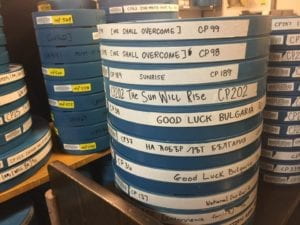Orphans in Space: Forgotten Films from the Final Frontier
special edition for Roger That! 2021
Teenage Cosmonauts
(Igor Rodachenko, USSR, 1979)
10 of 17 min.
Source: NYU Tamiment Library
Produced by the Ukrainian Newsreel Documentary Film Institute, this classic Soviet propaganda film was distributed (with English narration) by the Union of Soviet Societies for Friendship and Cultural Relations with Foreign Countries (Russian acronym VOKS). With its celebration of the space program and educational system, Teenage Cosmonauts was part of a larger effort to reconstruct Communism in the 1960s and 70s around the “new Soviet man.” The young cosmonauts represent the ideal citizen: smart, patriotic, and physically fit. They are part of a complex technological system, expressing agency, modernity, science, and economic development.
Teenage Cosmonauts opens with the image of a Soviet space monument of a silver rocket on a towering pedestal, followed by shots of museum exhibits designed to remind viewers of the Soviet Union’s pioneering role in space exploration, especially Yuri Gagarin’s first earth orbit in 1961. The film shows students at the Gagarin Cosmonaut Training Center in Star City, Russia, learning about aerodynamics and model building. There is a competition for the design of model rockets. Interestingly, most are replicas of actual Soviet rockets. The English narration translates one young girl’s on-camera response to an interviewer: she hopes to be the third female cosmonaut. (In 1963, Valentina Tereshkova became the first woman in space.) The sequence reinforces the idea of gender equality in the Soviet Union.
Toward the end of the film a model of a space city appears, and the cityscape comes alive with mechanized components as a satellite unfolds its solar panels. This is modernist science fiction with cave people battling a giant robot. The subtext is the cosmonaut heroes bravely flying into the unknown.
—
Michael Nash was head of NYU Tamiment Library and Robert F. Wagner Labor Archives at the time of his passing in 2012. Thanks to Shannon O’Neil, Curator for the Tamiment-Wagner Collections, and Kimberly Tarr, Head of the Media Preservation Unit, for aid in preparing the 2021 access.
Preservation note 2012 by Alice Moscoso and Erika Gottfried

Teenage Cosmonauts came to Tamiment Library in 2006 as part of the Archives of the Communist Party, USA. The CPUSA collection includes 148 film titles from 1935 to 1995 (421 reels), more than 1,000 videotapes, and 4,300 audiotapes from the USSR and United Sates. (Finding aid here.) Approximately two thirds of the films are 16mm release prints, in multiple languages, alongside some 35mm, 8mm, and Super 8 items. These include documentaries and nonfiction footage from around the world, originating, for example, in East Germany, North Vietnam, Cuba, Angola, and other nations. Archivists continue to process the collection, but initial indications are that much of the film material is available nowhere else in the U.S. and may contain unique items.
The CPUSA prints continue to be scanned and some preserved on film. The color composite print (665 feet in 16mm) of Teenage Cosmonauts (which probably originated in 35mm) was transferred to a DigiBeta videotape by PostWorks New York as a pro bono contribution to the Orphan Film Project. Subsequently its two reels have be scanned in 2k in NYU Bobst Library’s Barbara Goldsmith Preservation & Conservation Department.
Other CPUSA films have been presented at Orphans events by the library’s Media Preservation Unit, now headed by Kimberly Tarr.
- Let’s Get Acquainted (Kyiv Popular Science Film Studio, USSR, ca. 1972), introduced by Kim Tarr with Michael Grant for Orphans Online 2020 (video recording here).
- Angela Davis Report (DDR, 1972), Kim premiered the 16mm print at the Austrian Film Museum in 2019;
- What’s Happening in Harlem? (CPUSA, 1949) an expose about police brutality. After a screening of Craig Baldwin’s incomplete copy at Film Forum’s “Orphans of New York” in 2018, Kim Tarr discovered a soundtrack element for the film in the NYU collection. It runs 13 minutes; the Baldwin fragment 9.
- Passaic Textile Strike (International Workers Aid, US, 1926). The presumed-lost reel 5 from the storied labor film had several screenings and is included on the DVD Orphans 7: A Collection of Orphan Films, produced by NYU students in 2010. The badly deteriorate reel of 35mm nitrate was rescued by the Library of Congress archivist George Willeman. Prior to the successful film scan, George presented this slide show of individual frames at the first Orphans at NYU in 2008.
